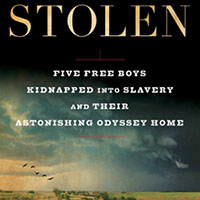Stolen: Five Free Boys Kidnapped into Slavery and Their Astonishing Odyssey Home
— A book review from David Turnoy —

Most people have heard about the Underground Railroad. Many of today’s children have learned of Harriet Tubman and other heroic figures who led enslaved African-Americans on journeys from the South to escape slavery by crossing the Ohio River and later, after the Fugitive Slave Act of 1850, going all the way to Canada. Both black and white Americans who opposed slavery and supported racial equality helped these escapees on their way to freedom by providing safe houses and by aiding in the journey. However, I recently learned of a perverse and reverse Underground Railroad, the selling of African-Americans in the North to slaveholders in the South, some of it actually legal and some of it involving kidnapping free black people. The book breaking this new historical ground is Stolen: Five Free Boys Kidnapped into Slavery and Their Astonishing Odyssey Home, written by Richard Bell, an early American history professor at the University of Maryland, and available at our library because our wonderful library folks acceded to my request to order the book.
You are probably aware of the vast slave trade that helped populate the American colonies. Millions of Africans were kidnapped by both Europeans and other Africans and thrown into horrible conditions on slave ships as part of a triangular trade. Many people did not survive the voyage, but the survivors helped to populate the colonies, especially in the South. The early successful cash crop that utilized slavery as its primary labor force was tobacco, which was very important to the economy of Virginia and North Carolina. But around the turn of the 19th century, tobacco prices dropped, and the need for vast quantities of labor decreased. Slaveholders in these areas needed the money they could get from selling their slaves south, and the labor of these African-Americans was needed in the Deep South, especially in Mississippi and Alabama, for cotton. The cotton gin had recently been invented, which made cotton a much more profitable crop, and as white Americans moved south to start cotton plantations in these two new states, they needed a source of labor. In addition, Louisiana developed a sugar cane industry, and slavery became rampant there as well.
Another factor in the need for African-American slaves was the fact that the slave trade involving the importation of Africans to the United State was outlawed in 1808. It is something that had been talked about at the earlier Constitutional Convention, but the Founding Fathers kicked the can down the road, as they knew they would not be able to get South Carolina and Georgia to approve the Constitution without continuing the slave trade. But by 1808 this trade was no longer legal. Where else could more slaves be found?
Besides the legal selling of enslaved African-Americans to licensed slave traders, who then brought them south to sell, gangs of kidnappers formed to kidnap free black people in the North. The movie Twelve Years a Slave chronicled the saga of Solomon Northrup, a well-educated free black man in the North who was kidnapped into slavery, taking twelve years to win his release. But unlike Solomon Northrup, most of the victims of this vicious kidnapping were black boys, not adults.
Stolen tells the story of five black boys, ranging in age from 8 to 15, who were kidnapped off the streets of Philadelphia, a city just barely in the North and containing a large population of free black Americans. Because black children were often hungry, it was easy for a scoundrel to offer some easy money for a quick job as a ruse to draw the child to a location where the child could be locked up and then spirited away. African-American parents were very aware of this and warned their children, but sometimes this wasn’t enough. And this is exactly what happened in the case of these five boys, who were kidnapped within a few days of each other in the summer of 1825. The person who lured them in was of mixed race, so it was all the easier to convince the boys of the safety of the offered employment. This mixed race fellow was part of one of the most notorious gangs of kidnappers, which was run mostly by white people. While kidnappers could be put to death after a trial if caught, the trade was quite lucrative, bringing in $400-700 per victim, equivalent to $9,000-15,000 today, so it was very tempting to people without scruples. The background of the historical circumstances involved is woven in with the story of these boys, so it is part history as well as part investigative expose’ or thriller.
In this particular series of events, the boys were first taken to a “safe house” in Delaware, where they were chained and abused. Unable to sell the boys at this time, the boys then traveled by boat and on foot, heading south, their captors hoping to sell them along the way. One was sold in Alabama, but the others had to continue walking barefoot on into Mississippi. They suffered hunger, cold, and beatings. I won’t tell you all the details of what later happened, but four of the five would survive and make it home.
The author claims that the reverse Underground Railroad transported about the same number of people as the other Underground Railroad, meaning hundreds of people per year were being kidnapped and forced into slavery, as many as tens of thousands during the first half of the 19th century. This makes it clear that simply escaping to the North was not enough to guarantee one’s freedom. While this is not a pleasant subject to read about, it is very important to learn about these previously untold parts of our history so that we have a better understanding of how we have come to be where we are today. Only by understanding the present through the past can we work intelligently for a better tomorrow.
**If you are reading theOrcasonian for free, thank your fellow islanders. If you would like to support theOrcasonian CLICK HERE to set your modestly-priced, voluntary subscription. Otherwise, no worries; we’re happy to share with you.**









What a compelling review, David. I will put this on my list.